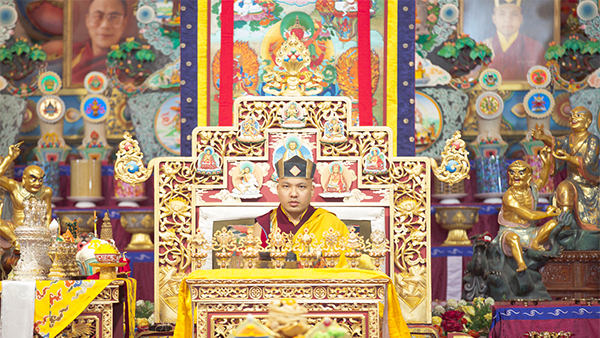
January 31st, 2014
Tergar Monastery, Bodhgaya
3.00 am. In the early morning darkness the only movement was from hundreds of festive red and golden fairy lights, strung in glittering garlands from the roof and walls of the temple. They swayed gently, their reflections shimmering in the windows. Suddenly, the stillness was rent by the call of Tibetan trumpets across the rooftops of Tergar Monastery: the Tibetan Year of the Male Wood Horse had arrived. Although the majority of Tibetans these days keep the Phukluk calendar, dating from 1447 CE and named after Phukpa Lhundrup Gyatso who founded the astrological tradition on which it is based, the Gyalwang Karmapas have preserved an earlier tradition. Known as the Tsurluk calendar, because of its association with Tsurphu Monastery, it is based on an astrological treatise The Compendium of Astrology compiled by the Third Karmapa Rangjung Dorje (1284 CE -1339 CE). It became popular during the time of the Seventh Karmapa Chodrak Gyatso, and remains the official calendar of the Karma Kamtsang to this day.
At 6.30 am Rinpoches, Khenpos, senior monks and the Gyalwang Karmapa’s staff met for a special private audience and puja in the small shrine room opposite his quarters on the roof of the shrine hall at Tergar Monastery.
Meanwhile, two storeys below, nuns, monks and laypeople began passing through the security checks and filing into the temple for the New Year long-life ritual to be offered to His Holiness by the abbot of Mirik Monastery, Khenpo Lodrö Dönyo Rinpoche.
The enormous golden throne had been brought down from the dais and placed in front of the rows of seating for monks and nuns. Garlands of gold and yellow marigolds interspersed with garlands of off-white and wine-red marigolds had been hung from the temple pillars and between the thangkas of the lineage forefathers and the Karmapas. In front of the throne, stood a special New Year altar, heaped high with fried Tibetan pastries called donkey’s ears because of their shape, fruit, sweets, dried fruit and nuts. In front of these were two ornately painted and carved wooden containers, one of chemar –Tibetan roasted barley flour mixed with butter and sugar–and one of roasted wheat. Planted in them were decorative butter sculptures mounted on wood. Finally, there were the traditional pots containing young sprouting wheat.
At 8.00am, amid clouds of incense, and to the beating of the great temple drums, the assembly of monks and nuns rose to greet the 17th Gyalwang Karmapa, led in procession by nuns in golden brocade robes. His Holiness was wearing his lesha, the black activity crown adorned with golden motifs, and clad in festival robes: a special tönka [monk’s waistcoat] panelled with golden brocade, embroidered white felt boots, and a decorative brocade chabshu hanging from his belt.
The long-life ritual itself was distinctive. Based on the pure vision of the Third Karmapa and a treasure revealed by the Eighth Karmapa, it is called the Long Life Practice of the Union of the Three Roots. The three roots are the Lama Guru Rinpoche, the yidam deities of Dorje Phagmo, Tamdin and Gyalwa Gyamtso a form of Red Chenrezig, and the protector is Mahakala Bernakchen. All were displayed on the thangka hung behind the golden throne, but as this is a long-life practice, the five are visualised as Amitayus, the deity associated with longevity.
The Arya Kshema Nuns Winter Gathering is still in progress, so the ritual itself was conducted by the nuns. The umzes were nuns, a nun acted as ritual master making the offerings at the altar, nuns played the gyalings, horns and cymbals, and nuns beat the two huge temple drums. Yet a further demonstration of how His Holiness is both encouraging and validating the empowerment of nuns in the Karma Kamtsang this year.
About 1500 people were crowded into the shrine room, many hundreds more gathered outside on the surrounding verandas, peering through the windows and doors to get a glimpse of His Holiness. After the puja, everyone had the opportunity to offer a katag to His Holiness. As more and more people arrived, it seemed that the line of devotees filing past the throne would never end. Indeed it took two hours for everyone-approximately 3000 people in all-to receive His Holiness’ New Year blessing, along with a red protection cord and an envelope of ‘seed’ money, to bring wealth and prosperity in the coming year.
In keeping with tradition, at the end of the line came the two oldest men, Tsering Dondrup, an 83-year-old Tibetan, and Tsering Dorjee, 86 years old, from Bhutan. Draped in white shawls and waving blue and yellow Karmapa dream flags, they were the concluding symbols of longevity, echoing the sincere prayer of all those present that the 17th Gyalwang Karmapa, Ogyen Trinley Dorje, embodiment of the activity of all the buddhas, might remain long in order to bring benefit to beings.


